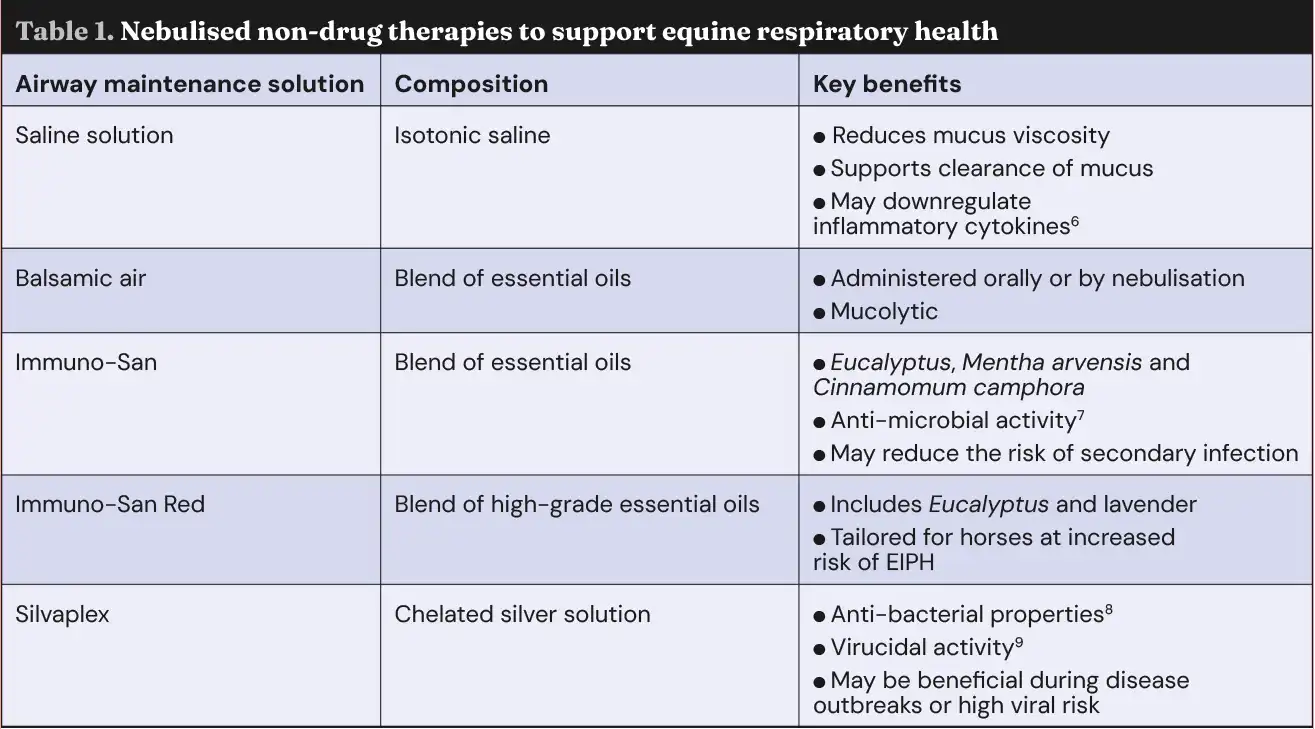Advertorial
01 September 2025
Optimising equine respiratory health through routine nebulisation
A discussion on how reductions in respiratory efficiency can impart equine performance and recovery – and how the Flexineb E3 can help.

Horses are uniquely limited when it comes to ventilation. As obligate nasal breathers, they have no ability to reduce airflow resistance through mouth-breathing. Even small reductions in respiratory efficiency can impair performance and recovery.
During high-intensity exercise, when oxygen demand is high, virtually all horses experience hypoxaemia (reduced blood oxygen levels) and hypercapnia (elevated carbon dioxide levels).1 Maintaining optimal lung function is therefore essential not only for achieving peak athletic performance in competition horses, but also for supporting general health and welfare in all equines.
Performance-limiting conditions
Two of the most common lower respiratory conditions impacting performance are equine asthma and exercise-induced pulmonary haemorrhage (EIPH). Equine asthma affects horses at all levels of activity, with severe forms estimated to impact 14% of the UK horse population.2 In the racing industry, equine asthma is the second most frequent cause of poor performance after orthopaedic disorders.3 Triggered by airborne allergens such as dust, mould or pollen, it causes chronic inflammation, airway thickening, and excess mucus. Without early intervention, progressive airway remodelling can occur, with long-term implications for welfare and performance.
EIPH results from high pulmonary pressures during intense exercise, causing rupture of delicate capillaries. While epistaxis occurs in only about 5% of cases, evidence of EIPH is found in over 90% of racehorses on bronchoalveolar lavage and in 75% on endoscopy.4 Even low-grade bleeding reduces oxygen exchange and contributes to airway inflammation and fibrosis over time – all of which can impair stamina, recovery, and competitive performance.
Nebulisation for management of equine respiratory disease

Alongside management changes to reduce exposure to allergens, nebulisation of prescribed medication remains the cornerstone of long-term management of equine asthma. Nebulisation, using devices like the Flexineb® E3 nebuliser, enables delivery of medications directly to the lungs and lower airways, reducing the side effects that may be associated with systemic administration. A 2018 study demonstrated that nebulised dexamethasone achieved therapeutic effects without hypothalamic-pituitary-adrenal (HPA) axis suppression in healthy horses.5
While nebulisers are a familiar part of treatment plans for asthmatic horses, there is increasing interest in using them more proactively for routine airway maintenance, both in performance horses, but also in pleasure horses with subclinical signs or a history of seasonal respiratory issues.
The role of non-drug therapies
Once clinical signs are under control, nebulised non-drug therapies can help maintain airway health, particularly during high-risk periods such as training peaks, travel, or pollen season. Inhaled saline, for example, acts as a mucolytic, reducing mucus viscosity and aiding clearance. This helps to keep airways open and may also support the removal of trapped allergens and pathogens. Emerging evidence suggests it may also help down-regulate key inflammatory cytokines.6
A variety of solutions can be nebulised to support respiratory health (Table 1). These therapies can be used alone or alongside prescribed medication, offering a flexible, proactive approach to managing and maintaining equine respiratory function. They may also help reduce reliance on systemic medication in recurrent cases.
It is also worth noting that nebulisation of non-prohibited substances, such as saline, is permitted under FEI General Regulations, making them a practical option for competition horses.

Practical, proactive respiratory care
With a growing understanding of the impact respiratory conditions have on both performance and long-term health, both vets and horse owners are increasingly looking beyond reactive treatment. Routine nebulisation – using both drug and non-drug therapies – offers a proactive approach to maintaining airway function, reducing inflammation, and supporting recovery.
Whether managing chronic conditions like equine asthma, supporting horses with a history of EIPH, or simply safeguarding the respiratory health of a hard-working competition horse, nebulisation has become a key part of long-term care protocols.
About the Flexineb

The Flexineb E3 delivers aerosolised medication and natural therapies to the airways of horses.
- Rapid, effective nebulisation
- Targeted delivery to the lungs and small airways
- Lightweight and portable
- Silent in use
- Battery or mains operated
- Up to 6 hours use from a single charge
- Available in foal, standard and large sizes
For more information on the Flexineb® or integrating nebulisation into your respiratory care protocols, visit www.breatheazy.co.uk or email [email protected]
References
- Mazan M (2022). Equine exercise physiology—challenges to the respiratory system, Animal Frontiers 12(3): 15-24. https://doi.org/10.1093/af/vfac035
- Scott Pirie R (2018). Severe equine asthma – an overview, Equine Health2018(39): 21-28.
- Lo Feudo CM et al (2022). Impact of lower airway inflammation on fitness parameters in Standardbred racehorses, Animals12(22): 3,228. https://doi.org/10.3390/ani12223228
- Lascola KM (2023). Exercise-induced pulmonary haemorrhage in horses, MSD Veterinary Manual.
- Haspel AD et al (2018). Bioavailability and tolerability of nebulised dexamethasone sodium phosphate in adult horses, Equine Vet J 50(1): 85-90. https://doi.org/10.1111/evj.12724
- Bond S and Léguillette R (2024). A Consort-guided, randomized controlled clinical trial of nebulized administration of dexamethasone and saline on lower airway cytokine mRNA expression in horses with moderate asthma, J Vet Intern Med38(2): 1,214-1,223. https://onlinelibrary.wiley.com/doi/10.1111/jvim.16983
- Van Erck-Westergren J et al. Anti-microbial and additional anti-inflammatory effects of inhaled essential oils in horses treated for IAD. World Equine Airway Symposium.
- Frippiat T et al (2021). Evaluation of the bactericidal effect of nebulized silver nanoparticles on common respiratory bacteria in horses – in vitro studies, J Equine Vet Sci 103: 103635.
- Frippiat T et al (2023). In vitro virucidal activity of nebulized citrate-complexed silver nanoparticles against equine herpesvirus-1 and murine norovirus. Virology 585:232-239.

